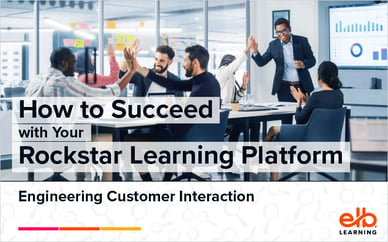For learning developers and training managers everywhere, creating an engaging learning experience that can be proven effective has long been the holy grail.
However, being able to track learner progress, prove ROI, and provide an engaging learner experience can be difficult.
To make it easier to deliver learning content, learning management systems (LMS) emerged. These platforms were developed as “management” systems for learning, focused on business rules, compliance, and catalog management for courses. Much of the focus was on the administrative backend of these systems, leaving the user experience, well...as an afterthought.
Over the past several years, a new kind of learning platform has emerged: the learning experience platform (LXP).
Josh Bersin describes the LXP as “a true content delivery system, which makes modern content easy to find and and consume.”
These platforms often resemble YouTube or Netflix and make searching for learning content a breeze.
The key difference between an LXP and LMS is that the LXP focuses on putting the learning experience first, whereas the LMS is based upon learning management.
LMS vs LXP
|
Learning Management System (LMS)
|
Learning Experience Platform (LXP or LEP)
|
The Evolution of an LMS to an LXP
We can trace the emergence of the learning experience platform to outside influences like the explosive growth of mobile technology, new advances in data consumption platforms, the growth of user-generated content, and innovative technologies like artificial intelligence, data analytics, and virtual reality.
According to Hootsuite, by Jan 2020, the number of mobile users had swelled to 5.19 billion users world-wide, which lead to a corresponding upsurge in mobile data consumption. (Admit it, you're never far away from your phone!)
More and more, organizations are realizing that learning does not have to happen at a desk.
Long-standing conventional wisdom in the L&D industry holds to the 70-20-10 model. This model posits that workers obtain 70 percent of their knowledge from job-related experiences, 20 percent from interactions with others, and only 10 percent from formal educational events, such as eLearning offered through a corporate LMS.
For their other learning experiences (the other 90%), workers turn to the internet and watch videos, listen to podcasts, or browse other content—primarily on a mobile device.
It’s easy to see how these trends influenced the development of a more mobile-friendly learning platform that reflected the ways workers were already accessing information on their own.
In addition to searching for content, individuals are constantly generating new content and sharing it with friends, colleagues, and the world.
In 2019, an estimated 4,500,000 YouTube videos were published every minute.
Workers are used to searching YouTube for how-to videos when they need to fix a leaking toilet, change their vehicle’s brake pads, or get red wine stains out of a couch cushion. They’re also sharing the content that they find helpful.
In a traditional LMS, the content is uploaded by an administrator and learners have little choice about what courses to view. An LXP often houses much more diverse media than an LMS, often user-generated. You’ll find videos, PDFs, links to external content, as well as eLearning courses.
Social Learning & Personalization
Learning experience platforms bring user-generated content and social learning to the table with features like:
- Areas for users to share content
- User-generated ratings systems
- Comments functionality
- Video annotations
- And more!
These social features help to increase user adoption and learning engagement in the LXP. Allowing users to rate and comment on training content in the LXP validates that content for other learners who are more likely to be interested in content recommended by their peers in similar job roles.
As learners browse peer-recommended content and scroll through the LXP, they are personalizing their learning journey—a growing trend in the training industry.
Some LXP also make use of AI technology or chatbots to recommend content based on user’s past activity or assessment results, creating a truly custom learning experience for each worker.
No learning platform is one-size-fits all, and these days you’ll find many learning management systems offering features similar to learning experience platforms, and vice versa. The best strategy to find the right platform for your organization is to schedule a demo of any platform you’re considering. During the demo you can ask questions about how the platform will address your organization’s specific needs.
Check out the features of our learning platform: The Rockstar Learning Platform and schedule a demo to see them in action.








